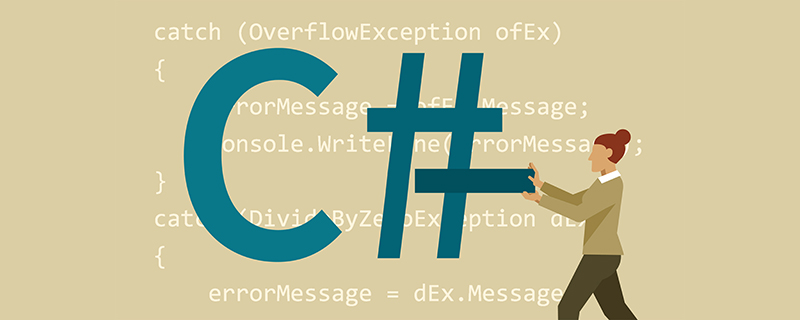Rumah >pembangunan bahagian belakang >Tutorial C#.Net >c#如何防止sql注入?
c#如何防止sql注入?
- 青灯夜游asal
- 2019-05-10 17:24:487387semak imbas
对于网站的安全性,是每个网站开发者和运营者最关心的问题。网站一旦出现漏洞,那势必将造成很大的损失。为了提高网站的安全性,首先网站要防注入。

下面我们给大家介绍C#防止sql注入的几种方法:
方法一:
在Web.config文件下面增加一个如下标签:
< appSettings> < add key="safeParameters" value="OrderID-int32,CustomerEmail-email,ShippingZipcode-USzip" /> < /appSettings>
其中key是 403c6cc3e9e4261fe0da1b089a4e2ef5后面的值为”OrderId-int32”等,其中”-“前面表示参数的名称比如:OrderId,后面的int32表示数据类型。
方法二:
在Global.asax中增加下面一段:
protected void Application_BeginRequest(Object sender, EventArgs e){
String[] safeParameters = System.Configuration.ConfigurationSettings.AppSettings["safeParameters"].ToString()。Split(',');
for(int i= 0 ;i < safeParameters.Length; i++){
String parameterName = safeParameters[i].Split('-')[0];
String parameterType = safeParameters[i].Split('-')[1];
isValidParameter(parameterName, parameterType);
}
}
public void isValidParameter(string parameterName, string parameterType){
string parameterValue = Request.QueryString[parameterName];
if(parameterValue == null) return;
if(parameterType.Equals("int32")){
if(!parameterCheck.isInt(parameterValue)) Response.Redirect("parameterError.aspx");
}
else if (parameterType.Equals("USzip")){
if(!parameterCheck.isUSZip(parameterValue)) Response.Redirect("parameterError.aspx");
}
else if (parameterType.Equals("email")){
if(!parameterCheck.isEmail(parameterValue)) Response.Redirect("parameterError.aspx");
}
}方法三:
使用字符串过滤类
/**//// < summary>
/// 处理用户提交的请求
/// < /summary>
public static void StartProcessRequest()
{
// System.Web.HttpContext.Current.Response.Write("< script>alert('dddd');< /script>");
try
{
string getkeys = ""; //string sqlErrorPage = System.Configuration.ConfigurationSettings.AppSettings["CustomErrorPage"].ToString();
if (System.Web.HttpContext.Current.Request.QueryString != null)
{
for(int i=0;i< System.Web.HttpContext.Current.Request.QueryString.Count;i++) {
getkeys = System.Web.HttpContext.Current.Request.QueryString.Keys[i]; if (!ProcessSqlStr(System.Web.HttpContext.Current.Request.QueryString[getkeys],0))
{
//System.Web.HttpContext.Current.Response.Redirect (sqlErrorPage+"?errmsg=sqlserver&sqlprocess=true");
System.Web.HttpContext.Current.Response.Write("< script>alert('请勿非法提交!');history.back();< /script>");
System.Web.HttpContext.Current.Response.End();
}
}
}
if (System.Web.HttpContext.Current.Request.Form != null)
{
for(int i=0;i< System.Web.HttpContext.Current.Request.Form.Count;i++) {
getkeys = System.Web.HttpContext.Current.Request.Form.Keys[i]; if (!ProcessSqlStr(System.Web.HttpContext.Current.Request.Form[getkeys],1))
{
//System.Web.HttpContext.Current.Response.Redirect (sqlErrorPage+"?errmsg=sqlserver&sqlprocess=true");
System.Web.HttpContext.Current.Response.Write("< script>alert('请勿非法提交!');history.back();< /script>");
System.Web.HttpContext.Current.Response.End();
}
}
}
}
catch
{
// 错误处理: 处理用户提交信息!
}
}
/**//// < summary>
/// 分析用户请求是否正常
/// < /summary>
/// < param name="Str">传入用户提交数据< /param>
/// < returns>返回是否含有SQL注入式攻击代码< /returns>
private static bool ProcessSqlStr(string Str,int type)
{
string SqlStr; if(type == 1)
SqlStr = "exec |insert |select |delete |update |count |chr |mid |master |truncate |char |declare "; else
SqlStr = "'|and|exec|insert|select|delete|update|count|*|chr|mid|master|truncate|char|declare"; bool ReturnValue = true; try
{
if (Str != "")
{
string[] anySqlStr = SqlStr.Split('|');
foreach (string ss in anySqlStr)
{
if (Str.IndexOf(ss)>=0)
{
ReturnValue = false; }
}
}
}
catch
{
ReturnValue = false; }
return ReturnValue; }
#endregion }
}相关视频教程推荐:《C#教程》
Atas ialah kandungan terperinci c#如何防止sql注入?. Untuk maklumat lanjut, sila ikut artikel berkaitan lain di laman web China PHP!
Kenyataan:
Kandungan artikel ini disumbangkan secara sukarela oleh netizen, dan hak cipta adalah milik pengarang asal. Laman web ini tidak memikul tanggungjawab undang-undang yang sepadan. Jika anda menemui sebarang kandungan yang disyaki plagiarisme atau pelanggaran, sila hubungi admin@php.cn
Artikel sebelumnya:sqlhelper类是什么Artikel seterusnya:c语言的代码是什么?

